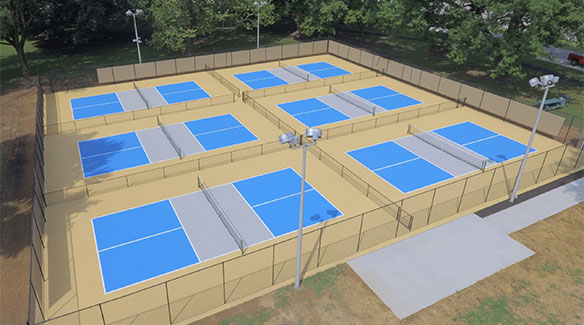Usual Mistakes to Avoid in Your Pickleball Court Construction Process
Boost Local Involvement With Community-Driven Pickleball Court Projects
The introduction of community-driven pickleball court tasks presents an unique opportunity to cultivate regional involvement and strengthen neighborhood ties. The actual concern remains: exactly how can these grassroots initiatives be tactically applied to guarantee sustainability and inclusivity in diverse areas?
Importance of Neighborhood Interaction
Neighborhood involvement is an essential aspect in the effective development of pickleball court projects, as it promotes a feeling of ownership and collective responsibility among locals. When community members are proactively entailed in the preparation and implementation stages, they are much more likely to promote for the task's long-term success. Involving stakeholders such as local gamers, families, and entertainment groups ensures that the facilities fulfill the diverse needs and choices of the area.
Moreover, area involvement grows a supportive setting where homeowners really feel equipped to contribute their sources and ideas. Pickleball court construction. This joint strategy can bring about cutting-edge options that improve the layout and capability of the courts, making them much more enticing to a larger audience. In addition, entailing locals in decision-making procedures can strengthen social ties, promoting inclusivity and unity within the neighborhood
The exposure of neighborhood assistance for a pickleball project can likewise play an essential duty in securing funding and authorization from regional authorities. By demonstrating a common commitment to entertainment growth, areas can properly support for sources and policy changes that favor the facility of pickleball courts, eventually enhancing the regional culture and leisure landscape.
Steps to Start a Job
Initiating a pickleball court task calls for a systematic method that constructs on the foundation of area involvement developed in previous conversations. The primary step is to set up a job board making up regional stakeholders, lovers, and representatives from appropriate organizations. This diverse team ensures that numerous viewpoints are taken into consideration.
Following, carry out a demands analysis within the neighborhood. Studies, emphasis teams, and public conferences can be efficient in gauging passion and event input on potential court locations, preferred features, and organizing preferences. Following this, create a project plan outlining duties, timelines, and purposes.
Once the strategy is in area, engage with neighborhood authorities to understand zoning regulations and any type of essential authorizations. Interacting transparently with the neighborhood throughout this procedure is essential, as it fosters depend on and urges additional involvement.
In addition, organizing neighborhood occasions can aid maintain momentum and excitement. These occasions can function as systems for more discussion and assistance to reinforce area connections. Last but not least, document every action taken and maintain detailed records, as this will certainly be useful for future stages of the task, consisting of financing and resource purchase.
Financing and Resources Available
Protecting funding and resources for a pickleball court job is often a crucial action that can determine the task's feasibility and success. Numerous avenues exist for obtaining monetary support, varying from public financing to private sponsorships. City government grants, usually focused on promoting area wellness and leisure, can provide substantial sponsorship for such efforts.
In addition to federal government sources, nonprofit companies and structures frequently supply gives especially for sports and neighborhood growth jobs. Engaging local companies as enrollers can likewise be a rewarding method; many companies are anxious to purchase area campaigns that boost their corporate social obligation account.
Crowdfunding platforms have actually emerged as a feasible choice for grassroots fundraising, making it possible for community members to contribute directly to the job. This method not just increases funds however also promotes a feeling of ownership amongst participants.
Design and Planning Factors To Consider
Effective layout and preparation are basic components of any effective pickleball court project adhering to the acquisition of funding and sources. A comprehensive evaluation of the recommended news location is important; this includes assessing availability, proximity to existing neighborhood facilities, and the capacity for visibility and interaction.
The layout of the court need to abide by main size requirements while considering the surrounding environment. Incorporating attributes such as seating, shade frameworks, and suitable lights can significantly boost gamer experience and viewer satisfaction. Products picked for the court surface area must prioritize longevity and safety and security, with options like acrylic or asphalt offering optimum performance.
Involving neighborhood members in the design procedure promotes a feeling of possession and makes sure that the facility satisfies local needs - Pickleball court construction. This can be achieved with public examinations and studies, permitting stakeholders to share their choices and problems
Sustainability needs to likewise be a top priority; incorporating green materials and Visit Website techniques can contribute to lasting viability. Ultimately, developing an upkeep strategy to make sure the court stays in superb condition will support ongoing neighborhood engagement and engagement in pickleball tasks.

Success Stories and Study
Highlighting the transformative effect of community-driven efforts, numerous success tales show exactly how joint initiatives have led to the advancement of lively pickleball courts throughout various areas. One noteworthy example is the initiative in a village in Florida, where citizens banded with each other to convert an underutilized tennis court right into a specialized pickleball facility. Through fundraising events and collaborations with regional businesses, the community raised adequate funds to install brand-new webs, resurfacing, and lines, eventually fostering a dynamic hub for neighborhood gamers.
In a similar way, in a country area of California, a grassroots activity arised to produce pickleball courts in a neighborhood park. The job not only engaged volunteers for building and construction but also consisted of workshops to involve area participants in the sport. Consequently, the courts ended up being a centerpiece for social communication and fitness, attracting players of any ages.
These study exhibit how community-driven tasks can enhance neighborhood involvement, advertise exercise, and reinforce social bonds. By leveraging collective sources and excitement, neighborhoods can successfully maintain and develop pickleball facilities that serve varied populaces and foster a feeling of belonging.

Final Thought
Finally, community-driven pickleball court tasks serve as crucial instruments for improving local engagement and cultivating a feeling of belonging amongst homeowners. By focusing on stakeholder involvement throughout the planning and implementation stages, these campaigns can effectively resolve varied neighborhood needs. Furthermore, leveraging available sources and examining effective study can supply useful insights for future projects. Ultimately, such initiatives add to the transformation of public areas right into vibrant facilities of physical fitness and social interaction, reinforcing community connections.
The introduction of community-driven pickleball court projects provides an one-of-a-kind chance to promote regional interaction and reinforce community connections.Neighborhood engagement is a crucial element in the successful growth of pickleball court jobs, as it cultivates a feeling of ownership and cumulative responsibility among locals. When her comment is here community participants are proactively involved in the planning and application stages, they are much more most likely to advocate for the project's lasting success.Starting a pickleball court task calls for a methodical approach that develops on the foundation of neighborhood involvement developed in previous conversations. The task not just engaged volunteers for building and construction however additionally consisted of workshops to involve neighborhood members in the sport.